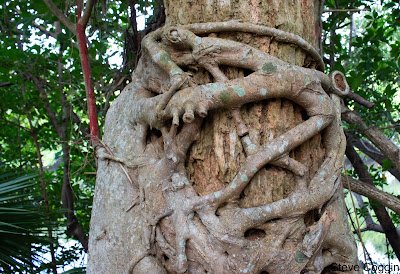 |
| A Strangler Fig (Ficus aurea) strangling a hardwood tree. Palm Beach County, Florida. |
What an ominous name, Strangler Fig. It suggests an exploitation flick with a dark night, a creaking door, and screams. But the real Strangler Figs (Ficus sp.) are slower and perhaps more insidious than villains in teen slasher movies.
 |
| A Strangler Fig on a hardwood tree. The leaves of the Strangler Fig are in the upper right of the photo. Lantana Nature Preserve, Palm Beach County, Florida. |
 |
| Strangler Fig leaves. Palm Beach County, Florida. |
The Florida Strangler Fig, Ficus aurea, grows in south Florida, the West Indies and Central America. Its story starts with a bird dropping a seed high in a tree. This seed germinates and begins life as an epiphyte on the host tree, doing photosynthesis, absorbing water and scarce nutrients from the air and bark. The Strangler Fig makes a few leaves then begins to send long roots down along the trunk of the host. If a root contacts the ground the Strangler Fig begin can begin rapid growth. More roots grow down and fuse eventually surrounding the trunk of the host tree, thus beginning the strangulation.
 |
| A Strangler Fig showing its extensive network of aerial roots. Palm Beach County, Florida. |
Branches of the Strangler Fig
grow into the canopy and where the broad leaves compete with the host for light. The Strangler Fig roots crowd the roots of
the host and deprive it of water and inorganic nutrients. Finally, the Stranger Fig encloses the host
tree. As the host grows in diameter its
vascular tissue is crushed by the surrounding wood of the fig. This prevents transport of sugars and kills
the host.
 |
| Strangler fig leaves. This is an early stage of growth on a Cabbage Palm (Sabal palmetto). Green Cay Wetlands, Palm Beach County, Florida. |
Not all host trees are at equal risk. Cabbage Palms (Sabal palmetto) are a commonly host of Strangler Figs in Florida. These small palms do not have secondary growth that increases their diameter and they are not crushed by the fig. Other tree species, at least early in their interaction with the Florida Strangler Fig, have some protection from hurricane winds because they get additional support from the fig.
 |
| Detail of a Strangler Fig on hardwood. Lantana Nature Preserve, Palm Beach County, Florida. |
When a host tree dies, the Strangler Fig remains behind. You can find the dead trunk of the original host still standing and occasionally the host trunk decays leaving a hollow chimney surrounded by a mature fig tree.
 |
| Strangler Fig. Lantana Nature Preserve, Palm Beach County, Florida. |
Some Strangler Fig seeds land on
the ground rather than high in a tree.
These seeds germinate and develop into free-standing Strangler Figs. These ground spouting trees still produce the
extensive aerial root system and sometimes the roots cover the ground around a
large trunk.
 |
| A Strangler Fig grown from a seed on the soil. Its root system covers the ground under the tree. Lantana Nature Preserve, Palm Beach County, Florida. |
The fruits of Strangler Figs are small
and they are an important food for many animals including bats, monkeys, birds and
insects. Some of the seeds eaten by
these creatures will be deposited in other trees and the cycle begins again.
 |
| Fruits of Strangler Fig. Palm Beach County, Florida. |
While their name suggests these
plants are a danger in their environment, they really play a vital role in the
ecosystem. In rainforests, the Florida
Strangler Fig is a keystone species of the forest canopy. They provide food for many animals and while
some host trees are strangled others are saved from high winds by the support of the
fig. If you are in the woods of south Florida or the
American tropics look for stranglers, but don’t fear the fig.
No comments:
Post a Comment